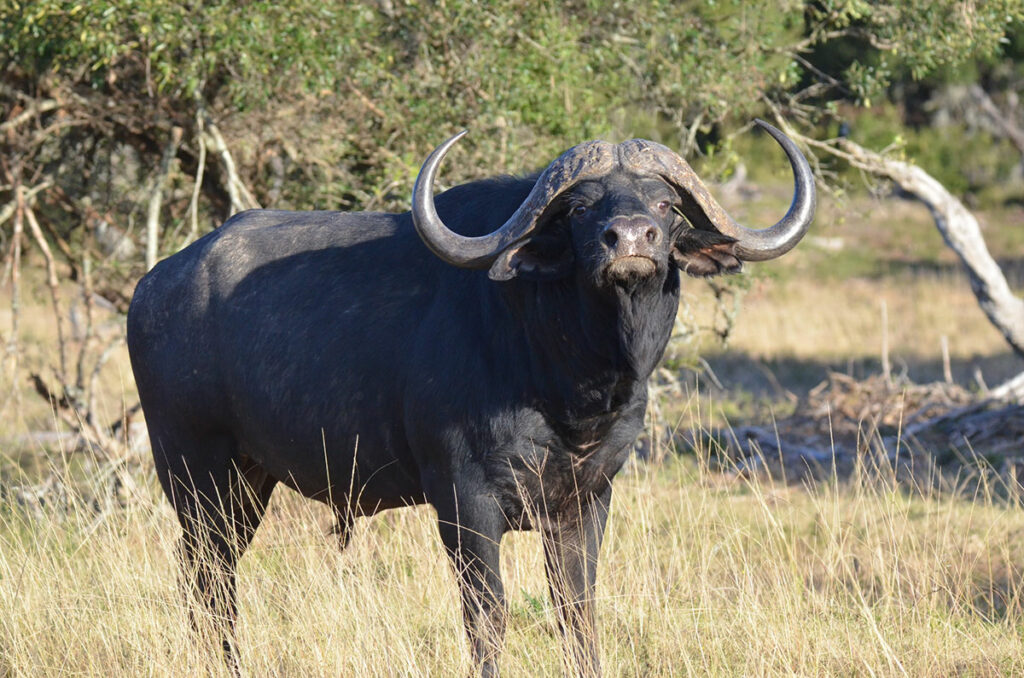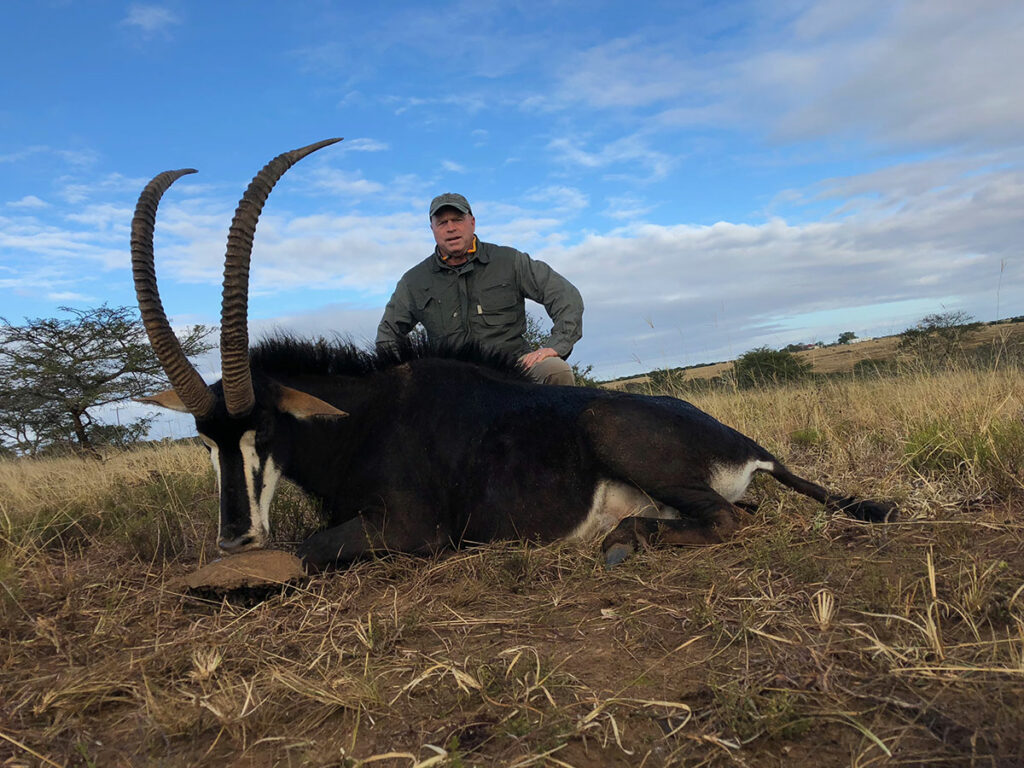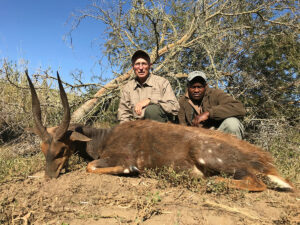Where Rhinos Roam
Buffalo Kloof proves hunting and wildlife conservation can coexist.
“We translocated and restored an elephant herd to our area, brought in 20 white rhinos, we’re working with the World Wildlife Fund on black rhino conservation and plan on re-introducing lion prides,” said Warne Rippon, owner of Buffalo Kloof Hunting and Conservation Reserve.

Interesting stories are the coin of the hunting realm, while visiting outfitters and professional hunters at the Safari Club International Convention. But I had never come across anything quite as intriguing as this.
Being a born skeptic, I walked down the aisle, pulled out my phone and went to Buffalo Kloof’s website. It featured a short video of veterinarians darting elephants and the mammoth creatures being loaded on to tractor/trailer rigs for transport to the 70,000-acre Buffalo Kloof Reserve, north of Port Elizebeth, South Africa. Over a dozen white rhino photos were also posted. The site had excellent reviews.
Perfect. I was looking for a place to hunt Cape bushbuck with a conservation story, with rhinos and elephants to make my African hunt an experience to savor. Rippon set up a hunt for me with Buffalo Kloof Wildlife Safaris. I wanted a trophy Cape bushbuck and the region is renowned for them.
Meanwhile, a friend, Mike Bouton’s burning desire to get a trophy Cape buffalo got the best of him and he scheduled a buffalo and plains game hunt at Buffalo Kloof Wildlife Safaris also. It worked out so we could overlap hunts. Mike would hunt with Professional Hunter Ralph Koster and PH Guy Brownrigg would guide me.
Arriving at the reserve, Warne asked if I would like to get a look at the 70,000-acre reserve from the air. He was patrolling the ranch by helicopter, keeping a close eye on his 20 white rhinos. Not your usual introduction to a hunting area and how often does a ranch owner own and pilot his own helicopter?
Airborne, he pointed out the two river valleys I would be hunting for bushbuck and the tangle of canyons and savannas where Mike would be hunting plains game and seeking his trophy buffalo. The area was vast and finding the rhinos took some keen spotting from the air. We didn’t see the elephant herd or any buffalo. Miles and miles of deep canyons and dense forest cover simply engulfed game.

Finding A 40-inch Trophy Cape Buffalo
What made Mike book a Cape buffalo hunt? He fell in love with a double rifle from the French riflemaker Chapuis Armes. The sleek, .450/400 Nitro Express double, topped with a Schmidt and Bender 1.5-4 scope energized him and turned a dream about hunting Cape buffalo into a reality. Mike booked his hunt with Buffalo Kloof because they integrated conservation ethics with a family feeling and provided a crack at a 40-inch Cape buffalo.
Professional Hunter Ralph Koster laid out the strategy they would use. He knew several deep canyons that held giant bulls. The first part of the hunt, they would work the edges of the rolling savannas, giving Mike a chance to take plains game trophies and get comfortable with the terrain while scouting for buffalo tracks. Once they found a lone bull or a group of dugga boy tracks, they would target them and pursue relentlessly.
Mike’s first score was a dandy eland. Glassing the fringes of the dense brush boarding rolling savanna they spotted a small herd of eland grazing. The herd was made up of females and young. Koster decided to spend some time glassing the herd to see if an interested bull might show. An hour later an old bull appeared but drifted away. A quick conference and they were headed out to intercept the bull.
A half-mile stalk put them on a ridge overlooking the small side valley the bull turned in to. It is amazing how a 2,000-pound animal can just disappear. A half-hour later they worked their way down the ridge and into another small canyon. The bull was resting in the shade150 yards away. Settling his .450/400 on the “sticks,” Mike squeezed the trigger and the bull fell. Then the work began. They were over a mile from the nearest dirt road.
Finding a trophy bush buck was more difficult than I had envisioned.
Guy, my PH, had three river valleys he wanted me to hunt. I wanted a trophy Cape bush buck. He had spotted record class animals in all of the areas. The catch was, they had eluded hunters over the past season. We were determined to change that.
The first valley Guy picked out for hunting bush buck was still in morning shadows when we peaked over the canyon lip, hoping to find animals out grazing. Females and small buck were scattered among the openings in the brush, but no mature bucks. A mile hike found us at a bend in the river with a small bench overlooking it. On a previous hunt Guy had spotted an outstanding buck coming to water here. We set up 150 yards away and glassed. Several small bucks and a half dozen females appeared in various portions of the canyon, but no big ones.

The evening hunt was unproductive. A wind rattled vegetation all around us and we saw a scattering of impala and blue wildebeest but no bush bucks. At dark a possible shooter grazed out along the stream bed but disappeared before we could assess its horns.
Meanwhile, Mike’s plains game hunt was going well but it took four days to spot the Cape buffalo he came to Africa for. The previous afternoon they followed the tracks of a small herd containing several big bull tracks. It took several hours to work their way into a shooting position. One bull was a dandy. Koster estimated it was several inches over the 40-inch mark. With light fading and the big bull not presenting a perfect shot, they decided to back out and come after the bull at first light. Mike had the bull in his scope and the vision haunted him all night.
At first light, they found the herd as it was leaving the savanna and heading into thick brush and boulders. Mike sprinted to get above the herd. No luck. As they looked upslope, two bulls slowly ambled out and headed for thick cover. At 180 yards they were moving out of range. Koster told Mike to shoot the first one. What happened to the under 50-yard shot, wondered Mike?
The .450 bullet pierced the bull’s lungs. It stumbled and summersaulted, landing on its back and regained its footing as Mike’s second shot anchored the bull, killing it. Surprisingly, the buffalo herd moved in and milled around the fallen bull. They waited and as the herd dispersed, carefully approached the mammoth animal. Laying his rifle across the curling black horns, Mike had realized his dream of a 40-inch Cape buffalo with two inches to spare. Thick, wide and massive, it was all he had hoped for and more. For Mike, this was the highlight of an extensive hunting career.
Elephants, Bush Bucks and A Red Hartebeest Wrap Up the Hunt
The following morning as we edged the Land Rover through a creek, we came face-to-face with a dozen elephants. At 20-yards even the babies looked big. Not spooked, they gave me enough time for several pictures and then with an ear flap from the matriarch, they vanished. Wow.

It was eerie, how elephants could disappear so silently. Guy led me along the same stream bed, treading very carefully. Twice in thick cover we busted good bushbucks in the 14 to15-inch class, but they were gone before I could get a shot. But the image of the elephants haunted the area. It was time to move.
Guy had one more place to check before the morning hunt was over. Bumping over a dirt road, we stopped to glass a hillside. There, standing in the open was the biggest buck of the trip, 300 yards away. A short stalk brought us within 125 yards and the shot was true. Measuring over 15 inches with a dark cape, it was all I had hoped for.
Ten miles away, Mike and Koster sat up on the highest ridge on the ranch, glassing. Resting on sandbags was Mike’s new McWhorter rifle chambered in 7MM STW with a Swarovski 5-30×50 scope.
Below them a herd of red hartebeest grazed. A magnificent bull that had lived a charmed life due to the dense foliage surrounding the grazing area strolled below them. Koster had seen the tight groups Mike shot when he was sighting-in his rifle at the ranch and believed he could make the shot. Mike settled in behind the rifle and dialed up the distance. Seconds later the 180-grain Burger bullet instantly killed one of the best red hartebeest taken on the ranch.
Returning to camp both of us were ecstatic about our morning’s hunt. At camp eight rhinos were huddled around five hay bales, beating us to lunch.
The Rest of the Buffalo Kloof Story
We were invited to join the Rippon family at their family camp to celebrate their love of the outdoors. Their hospitality made us feel like family members at a special campout.
Celebrating around the campfire, we asked Warne and Wendy Rippon their plans for this massive chunk of territory. Their main goal is to create a Big Five conservancy. They want to introduce two prides of lions and black rhinos in the future if all goes well. An amazing turnaround since elephants and rhinos were eradicated here over 100 years ago, before his parents ranched in this area.

They see hunting as a major contributor to restoring the Big Five at Buffalo Kloof. Not only does it provide funding for reserve operations and keep fast growing species in check, it provides eyes in the field to spot any suspicious activity connected to poaching. Each of their rhino’s horns are infused with a dye and toxin, which are not harmful to animals but poisonous to humans. It is an extra step towards stopping poaching. All 20 rhinos are potential targets for horn poachers and require ground and aerial surveillance.
These keystone species are part of restoring a natural ecosystem from the ground up, where elephant and rhino will never be hunted. Meanwhile, removing non-native vegetation, reintroducing native plants and grasses, stabilizing stream beds and soil are all part of a process forecasted to take 30-40 years. Their hope is to leave a restored ecosystem in their family’s care for the future.–Harry Morse



